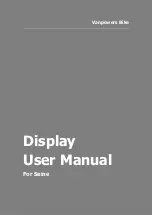
#21
#20
i
WarNiNg: There is a safeTy risk iN UsiNg gas sTaTioN air
hoses or oTher air comPressors. They are NoT made
for bicycle Tires. They move a large volUme of air
very raPidly, aNd Will raise The PressUre iN yoUr Tire
very raPidly, Which coUld caUse The TUbe To exPlode.
Tire pressure is given either as maximum pressure or as a pressure range. How a tire
performs under different terrain or weather conditions depends largely on tire pressure.
Inflating the tire to near its maximum recommended pressure gives the lowest rolling
resistance, but also produces the harshest ride. High pressures work best on smooth,
dry pavement. (See Image 2)
Very low pressures, at the bottom of the recommended pressure range, give the best
performance on smooth, slick terrain such as hard-packed clay, and on deep, loose
surfaces such as deep, dry sand. Tire pressure that is too low for your weight and
the riding conditions can cause a puncture of the tube by allowing the tire to deform
sufficiently to pinch the inner tube between the rim and the riding surface.
i
caUTioN: PeNcil TyPe aUTomoTive Tire gaUges caN be
iNaccUraTe aNd shoUld NoT be relied UPoN for coN-
sisTeNT, accUraTe PressUre readiNgs. iNsTead, Use a
high qUaliTy dial gaUge.
Your SHINOLA bicycle will be delivered with the tires inflated to the recommended
pressure. Before you ride it, check inflation as described in Section 1.C so you’ll know
how correctly inflated tires should look and feel when you don’t have access to a
gauge. Some tires may need to be brought up to pressure every week or two, so it is
important to check your tire pressures before every ride.
Some special high-performance tires have unidirectional treads: their tread pattern is
designed to work better in one direction than in the other. The sidewall marking of a
unidirectional tire will have an arrow showing the correct rotation direction. If your bicycle
has unidirectional tires, be sure that they are mounted to rotate in the correct direction.
2. tire Valves:
There are primarily two kinds of bicycle tube valves: The Schraeder valve
and the Presta valve. The bicycle pump you use must have the fitting appropriate to the
valve stems on your bicycle.
The Schraeder valve is like the valve on a car tire. To inflate a Schraeder valve tube,
remove the valve cap and clamp the pump fitting onto the end of the valve stem. To let
air out of a Schraeder valve, depress the pin in the end of the valve stem with the end
of a key or other appropriate object.
The Presta valve has a narrower diameter and is only found on bicycle tires. To inflate a
Presta valve tube using a Presta headed bicycle pump, remove the valve cap; unscrew
(counterclockwise) the valve stem lock nut; and push down on the valve stem to free it
up. Then push the pump head on to the valve head, and inflate. To inflate a Presta valve
with a Schraeder pump fitting, you’ll need a Presta adapter (available at your bicycle
shop) which screws on to the valve stem once you’ve freed up the valve. The adapter
fits into the Schraeder pump fitting. Close the valve after inflation. To let air out of a
Presta valve, open up the valve stem lock nut and depress the valve stem.
i
WarNiNg: We highly recommeNd ThaT yoU carry a
sPare iNNer TUbe WheN yoU ride yoUr bicycle. PaTch-
iNg a TUbe is aN emergeNcy rePair. if yoU do NoT aPPly
The PaTch correcTly or aPPly several PaTches, The
TUbe caN fail, resUlTiNg iN Possible TUbe failUre,
Which coUld caUse yoU To lose coNTrol aNd fall.
rePlace a PaTched TUbe as sooN as Possible.
Summary of Contents for bicycle
Page 14: ......
































